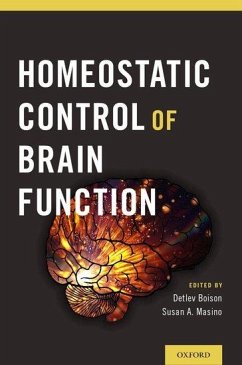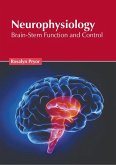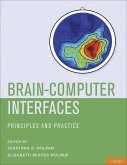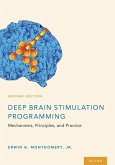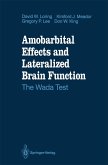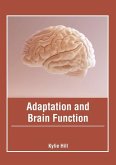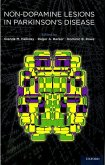Homeostatic Control of Brain Function
Herausgeber: Boison, Detlev; Masino, Susan A
Homeostatic Control of Brain Function
Herausgeber: Boison, Detlev; Masino, Susan A
- Gebundenes Buch
- Merkliste
- Auf die Merkliste
- Bewerten Bewerten
- Teilen
- Produkt teilen
- Produkterinnerung
- Produkterinnerung
Homeostatic Control of Brain Function offers a broad view of brain health and diverse perspectives for potential treatments, targeting key areas such as mitochondria, the immune system, epigenetic changes, and regulatory molecules such as ions, neuropeptides, and neuromodulators. Loss of homeostasis becomes expressed as a diverse array of neurological disorders.
Andere Kunden interessierten sich auch für
![Neurophysiology: Brain-Stem Function and Control Neurophysiology: Brain-Stem Function and Control]() Neurophysiology: Brain-Stem Function and Control147,99 €
Neurophysiology: Brain-Stem Function and Control147,99 €![Brain-Computer Interfaces Brain-Computer Interfaces]() Brain-Computer Interfaces282,99 €
Brain-Computer Interfaces282,99 €![Deep Brain Stimulation Programming Deep Brain Stimulation Programming]() Erwin B MontgomeryDeep Brain Stimulation Programming153,99 €
Erwin B MontgomeryDeep Brain Stimulation Programming153,99 €![Current Research in Brain Function Augmentation Current Research in Brain Function Augmentation]() Current Research in Brain Function Augmentation160,99 €
Current Research in Brain Function Augmentation160,99 €![Amobarbital Effects and Lateralized Brain Function Amobarbital Effects and Lateralized Brain Function]() David W. LoringAmobarbital Effects and Lateralized Brain Function100,99 €
David W. LoringAmobarbital Effects and Lateralized Brain Function100,99 €![Adaptation and Brain Function Adaptation and Brain Function]() Adaptation and Brain Function153,99 €
Adaptation and Brain Function153,99 €![Non-Dopamine Lesions in Parkinson's Disease Non-Dopamine Lesions in Parkinson's Disease]() Non-Dopamine Lesions in Parkinson's Disease216,99 €
Non-Dopamine Lesions in Parkinson's Disease216,99 €-
-
-
Homeostatic Control of Brain Function offers a broad view of brain health and diverse perspectives for potential treatments, targeting key areas such as mitochondria, the immune system, epigenetic changes, and regulatory molecules such as ions, neuropeptides, and neuromodulators. Loss of homeostasis becomes expressed as a diverse array of neurological disorders.
Hinweis: Dieser Artikel kann nur an eine deutsche Lieferadresse ausgeliefert werden.
Hinweis: Dieser Artikel kann nur an eine deutsche Lieferadresse ausgeliefert werden.
Produktdetails
- Produktdetails
- Verlag: Oxford University Press
- Seitenzahl: 658
- Erscheinungstermin: 1. Dezember 2015
- Englisch
- Abmessung: 257mm x 180mm x 36mm
- Gewicht: 1542g
- ISBN-13: 9780199322299
- ISBN-10: 0199322295
- Artikelnr.: 47868465
- Herstellerkennzeichnung
- Libri GmbH
- Europaallee 1
- 36244 Bad Hersfeld
- gpsr@libri.de
- Verlag: Oxford University Press
- Seitenzahl: 658
- Erscheinungstermin: 1. Dezember 2015
- Englisch
- Abmessung: 257mm x 180mm x 36mm
- Gewicht: 1542g
- ISBN-13: 9780199322299
- ISBN-10: 0199322295
- Artikelnr.: 47868465
- Herstellerkennzeichnung
- Libri GmbH
- Europaallee 1
- 36244 Bad Hersfeld
- gpsr@libri.de
Detlev Boison is the Robert Stone Dow Chair of Neurology; the Director of Neurobiology Research; and the Director of Basic and Translational Research at the Legacy Research Institute Susan A. Masino is the Vernon Roosa Professor of Applied Science; and a Professor of Neuroscience and Psychology at Trinity College
* Prologue
* Part I: Homeostatic Regulators: Molecules and Ions
* Chapter 1: Microdynamics of water and ion homeostasis in the brain:
role of aquaporins and ion channels of astroglial cells
* Chapter 2: Homeostatic control of adenosine levels and functions in
brain
* Chapter 3: Glutamate homeostasis as a regulatory of neurotransmitter
recycling and synaptic function)
* Chapter 4: Homeostasis of neuronal excitability via synaptic and
intrinsic inhibitory mechanisms
* Part II: Homeostatic Control: Systems, Cells and Organelles
* Chapter 5: Role of astrocytes in sleep and epilepsy
* Chapter 6: Neuron-astrocyte interactions
* Chapter 7: Homeostatic synaptic scaling at central synapses
* Chapter 8: Homeostatic role of heterosynaptic plasticity
* Chapter 9: The Blood Brain Barrier
* Chapter 10: Inflammation and immunomodulation in epilepsy and its
comorbidities
* Chapter 11: Neuroplasticity
* Chapter 12: Epigenetics
* Chapter 13: Adult neural stem cells and brain homeostasis
* Part III: Homeostatic Manipulators: Preventative and Restorative
Opportunities
* Chapter 14: Systems (network) pharmacology for brain functionality
restoration
* Chapter 15: Ketogenic diets, mitochondria, and neurological diseases
* Chapter 16: Dietary manipulations
* Chapter 17: Exercise
* Chapter 18: Sleep
* Chapter 19: Botanicals
* Chapter 20: The role of acupuncture in nociception homeostasis
* Chapter 21: Meditation
* Chapter 22: Neurotrophic regulation in neurorestoration of brain
* Part IV: Homeostatic Therapies for Disease and Dysfunction
* Chapter 23: Epilepsy
* Chapter 24: Traumatic Brain Injury
* Chapter 25: Adenosine and Alzheimer's Disease, a possible epigenetic
link
* Chapter 26: Brain homeostasis and Parkinson's Disease
* Chapter 27: Brain homeostasis and addiction
* Chapter 28: Anxiety and stress disorders
* Chapter 29: Malignant brain cancer management with metabolic therapy
* Chapter 30: Obesity and diabetes: Nature, nurture, and beyond
* Chapter 31: Autism spectrum disorders and homeostasis
* Part I: Homeostatic Regulators: Molecules and Ions
* Chapter 1: Microdynamics of water and ion homeostasis in the brain:
role of aquaporins and ion channels of astroglial cells
* Chapter 2: Homeostatic control of adenosine levels and functions in
brain
* Chapter 3: Glutamate homeostasis as a regulatory of neurotransmitter
recycling and synaptic function)
* Chapter 4: Homeostasis of neuronal excitability via synaptic and
intrinsic inhibitory mechanisms
* Part II: Homeostatic Control: Systems, Cells and Organelles
* Chapter 5: Role of astrocytes in sleep and epilepsy
* Chapter 6: Neuron-astrocyte interactions
* Chapter 7: Homeostatic synaptic scaling at central synapses
* Chapter 8: Homeostatic role of heterosynaptic plasticity
* Chapter 9: The Blood Brain Barrier
* Chapter 10: Inflammation and immunomodulation in epilepsy and its
comorbidities
* Chapter 11: Neuroplasticity
* Chapter 12: Epigenetics
* Chapter 13: Adult neural stem cells and brain homeostasis
* Part III: Homeostatic Manipulators: Preventative and Restorative
Opportunities
* Chapter 14: Systems (network) pharmacology for brain functionality
restoration
* Chapter 15: Ketogenic diets, mitochondria, and neurological diseases
* Chapter 16: Dietary manipulations
* Chapter 17: Exercise
* Chapter 18: Sleep
* Chapter 19: Botanicals
* Chapter 20: The role of acupuncture in nociception homeostasis
* Chapter 21: Meditation
* Chapter 22: Neurotrophic regulation in neurorestoration of brain
* Part IV: Homeostatic Therapies for Disease and Dysfunction
* Chapter 23: Epilepsy
* Chapter 24: Traumatic Brain Injury
* Chapter 25: Adenosine and Alzheimer's Disease, a possible epigenetic
link
* Chapter 26: Brain homeostasis and Parkinson's Disease
* Chapter 27: Brain homeostasis and addiction
* Chapter 28: Anxiety and stress disorders
* Chapter 29: Malignant brain cancer management with metabolic therapy
* Chapter 30: Obesity and diabetes: Nature, nurture, and beyond
* Chapter 31: Autism spectrum disorders and homeostasis
* Prologue
* Part I: Homeostatic Regulators: Molecules and Ions
* Chapter 1: Microdynamics of water and ion homeostasis in the brain:
role of aquaporins and ion channels of astroglial cells
* Chapter 2: Homeostatic control of adenosine levels and functions in
brain
* Chapter 3: Glutamate homeostasis as a regulatory of neurotransmitter
recycling and synaptic function)
* Chapter 4: Homeostasis of neuronal excitability via synaptic and
intrinsic inhibitory mechanisms
* Part II: Homeostatic Control: Systems, Cells and Organelles
* Chapter 5: Role of astrocytes in sleep and epilepsy
* Chapter 6: Neuron-astrocyte interactions
* Chapter 7: Homeostatic synaptic scaling at central synapses
* Chapter 8: Homeostatic role of heterosynaptic plasticity
* Chapter 9: The Blood Brain Barrier
* Chapter 10: Inflammation and immunomodulation in epilepsy and its
comorbidities
* Chapter 11: Neuroplasticity
* Chapter 12: Epigenetics
* Chapter 13: Adult neural stem cells and brain homeostasis
* Part III: Homeostatic Manipulators: Preventative and Restorative
Opportunities
* Chapter 14: Systems (network) pharmacology for brain functionality
restoration
* Chapter 15: Ketogenic diets, mitochondria, and neurological diseases
* Chapter 16: Dietary manipulations
* Chapter 17: Exercise
* Chapter 18: Sleep
* Chapter 19: Botanicals
* Chapter 20: The role of acupuncture in nociception homeostasis
* Chapter 21: Meditation
* Chapter 22: Neurotrophic regulation in neurorestoration of brain
* Part IV: Homeostatic Therapies for Disease and Dysfunction
* Chapter 23: Epilepsy
* Chapter 24: Traumatic Brain Injury
* Chapter 25: Adenosine and Alzheimer's Disease, a possible epigenetic
link
* Chapter 26: Brain homeostasis and Parkinson's Disease
* Chapter 27: Brain homeostasis and addiction
* Chapter 28: Anxiety and stress disorders
* Chapter 29: Malignant brain cancer management with metabolic therapy
* Chapter 30: Obesity and diabetes: Nature, nurture, and beyond
* Chapter 31: Autism spectrum disorders and homeostasis
* Part I: Homeostatic Regulators: Molecules and Ions
* Chapter 1: Microdynamics of water and ion homeostasis in the brain:
role of aquaporins and ion channels of astroglial cells
* Chapter 2: Homeostatic control of adenosine levels and functions in
brain
* Chapter 3: Glutamate homeostasis as a regulatory of neurotransmitter
recycling and synaptic function)
* Chapter 4: Homeostasis of neuronal excitability via synaptic and
intrinsic inhibitory mechanisms
* Part II: Homeostatic Control: Systems, Cells and Organelles
* Chapter 5: Role of astrocytes in sleep and epilepsy
* Chapter 6: Neuron-astrocyte interactions
* Chapter 7: Homeostatic synaptic scaling at central synapses
* Chapter 8: Homeostatic role of heterosynaptic plasticity
* Chapter 9: The Blood Brain Barrier
* Chapter 10: Inflammation and immunomodulation in epilepsy and its
comorbidities
* Chapter 11: Neuroplasticity
* Chapter 12: Epigenetics
* Chapter 13: Adult neural stem cells and brain homeostasis
* Part III: Homeostatic Manipulators: Preventative and Restorative
Opportunities
* Chapter 14: Systems (network) pharmacology for brain functionality
restoration
* Chapter 15: Ketogenic diets, mitochondria, and neurological diseases
* Chapter 16: Dietary manipulations
* Chapter 17: Exercise
* Chapter 18: Sleep
* Chapter 19: Botanicals
* Chapter 20: The role of acupuncture in nociception homeostasis
* Chapter 21: Meditation
* Chapter 22: Neurotrophic regulation in neurorestoration of brain
* Part IV: Homeostatic Therapies for Disease and Dysfunction
* Chapter 23: Epilepsy
* Chapter 24: Traumatic Brain Injury
* Chapter 25: Adenosine and Alzheimer's Disease, a possible epigenetic
link
* Chapter 26: Brain homeostasis and Parkinson's Disease
* Chapter 27: Brain homeostasis and addiction
* Chapter 28: Anxiety and stress disorders
* Chapter 29: Malignant brain cancer management with metabolic therapy
* Chapter 30: Obesity and diabetes: Nature, nurture, and beyond
* Chapter 31: Autism spectrum disorders and homeostasis

